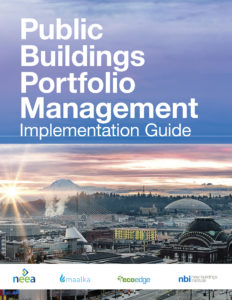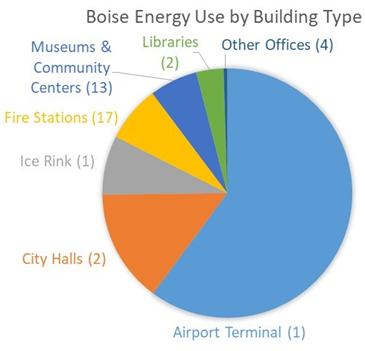For communities across the United States that are committed to implementing policies and practices that advance the goals of the Paris Climate Agreement, buildings represent a golden opportunity to lead by example. Overall, about 20% of the nation’s building floorspace is owned by state and local governments (According to the 2012 Commercial Buildings Energy Consumption Survey, Table B-18). Yet most small and medium-sized cities, states, and special districts lack the capacity to develop an effective approach for tracking, managing, and strategically upgrading public building performance.
Over the last five years, NBI and partners EcoEdge and Maalka have been working to create a practical and affordable framework that enables cities to better understand how their buildings use energy, how they compare to similar buildings around the country, and to inform strategic decision making for efficiency improvements. This framework is accompanied by an integrated set of open-source software tools and free resources for cities. Support was provided in part by the Northwest Energy Efficiency Alliance.
Under the Community Building Renewal pilot, a select group of cities agreed to test the framework (I wrote about the early phases of the program in a previous blog) and we have since developed the process into a guidebook  called the Public Buildings Portfolio Management Implementation Guide. In addition to the guide, NBI has curated a set of over 30 additional resources that further support states and local governments that want to reduce energy use and carbon emissions in both their own publicly owned commercial portfolios as well as buildings in the greater community. See the State and Local Governments Toolkit to learn more.
called the Public Buildings Portfolio Management Implementation Guide. In addition to the guide, NBI has curated a set of over 30 additional resources that further support states and local governments that want to reduce energy use and carbon emissions in both their own publicly owned commercial portfolios as well as buildings in the greater community. See the State and Local Governments Toolkit to learn more.
Cities target buildings as a critical focus for carbon reduction efforts
As buildings account for 40% of emissions in the U.S. and up to 75% in cities, our pilot cities, including Boise, Cambridge, Eugene, Grand Rapids, Missoula, Pittsburgh, Providence, and Tacoma, understand that building efficiency must be part of their strategic approach to climate action and had already made formal commitments for reducing carbon emissions. The city of Boise, for example, began working on their carbon reduction goals in 2006 when Mayor Dave Bieter joined over 1,000 other mayors in signing the Mayor’s Climate Protection Agreement. In Tacoma, the city’s Climate Action Plan set a greenhouse gas emission reduction target of 40% over 1990 levels by the year 2020. The city of Eugene has set a goal to be carbon neutral in all city operations by 2020. Similarly, the city of Missoula has set a goal to be carbon neutral in all city operations by 2025.
Despite public commitments and climate action planning, none of these cities had found an effective way to address carbon emissions from existing local building stock. As such, each of these communities was motivated to lead by example by improving the energy performance of their own building portfolios. To get started, we used NBI’s FirstView® software tool to complete a virtual energy audit of each city’s building portfolio using monthly energy bills. NBI used FirstView to evaluate how each municipal building’s energy use patterns compare to its peers and to diagnose opportunities for improvements in operations and equipment. The results of this analysis fed directly into a strategic planning and prioritization process designed to help cities develop concrete, achievable plans that clearly describe the role municipal buildings will play in meeting broader carbon reduction goals.
Providence is committed to leading by example and preparing our City to be a carbon-neutral City by 2050.
–Providence Mayor Jorge Elorza
In addition to the analysis, the Community Strategic Energy Management process takes cities through a whole series of steps to get them on the path to lower carbon emissions. Steps include stakeholder engagement, goal setting, benchmarking and analysis as described, targeted field analysis, planning and execution as well as financing.
Key findings and action taken by the jurisdictions we worked with ranged from existing building upgrades to new policy development. Some of the highlights include:
-
- The city of Grand Rapids was able to calculate a 7.8% total weather-normalized energy reduction across approximately 200 city facilities through 2017. Six municipal buildings were Energy Star Certified in 2018, which established Grand Rapids as a national leader in this area (in 2017, only five other cities had more than 6 buildings certified).
 The city of Boise analyzed 50 municipal buildings and identified 17 high-priority buildings that use about 70% of all energy in the city’s portfolio. (The airport terminal alone accounts for more than half of all energy portfolio-wide.) The city is now focusing limited auditing resources on the highest-priority buildings across the entire building portfolio.
The city of Boise analyzed 50 municipal buildings and identified 17 high-priority buildings that use about 70% of all energy in the city’s portfolio. (The airport terminal alone accounts for more than half of all energy portfolio-wide.) The city is now focusing limited auditing resources on the highest-priority buildings across the entire building portfolio.- In Missoula, the city has budgeted for the continuation of the energy team and an employee to focus on energy data and efficiency. City Council members noted that there is a lot of appetite for this work in the community. Even the media has engaged and shared progress with the community.
- In Eugene, the team was committed to evaluating the city’s building policies regarding operations, procurement, and green building design and construction. They created a comprehensive description of all of the policies to consolidate and effectively communicate to city staff to institutionalize and regularly update these policies to reflect the city’s robust goals.
- In Tacoma, the city solidified a great partnership with Tacoma Public Utilities’ engineers and account representatives, who not only helped make utility data available for benchmarking, but also committed to helping the city with ongoing benchmarking and identifying energy-saving opportunities.
 Cities can model effective action in their own building portfolios
Cities can model effective action in their own building portfolios
Today, the Public Buildings Portfolio Management (formerly Community Strategic Energy Management) project has moved beyond pilots and is open to any municipality, school district, state government, or other public entity looking for ways to lead by example and save taxpayers money with lower energy expenses. NBI can assist with not only analytics and planning, but with implementation, ongoing monitoring, and financing strategies. - Contact Alexi Miller, NBI senior program manager, at [email protected] to learn more.
